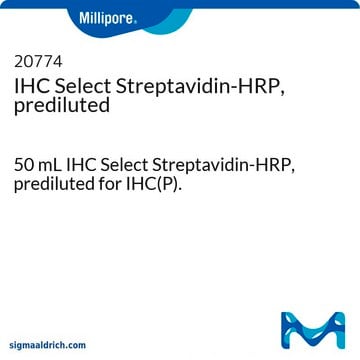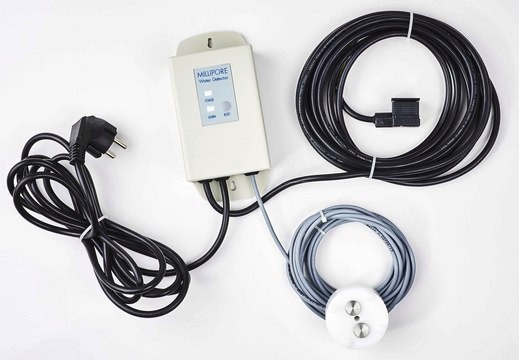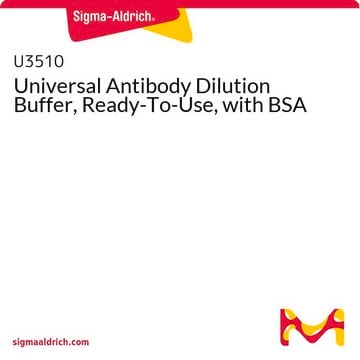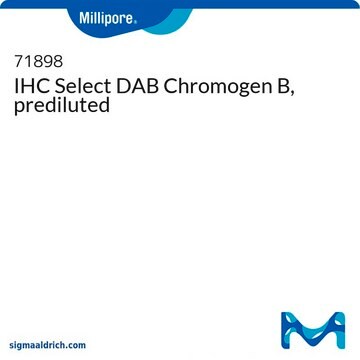DET-HP1000
IHC Select HRP Detection Set, (Blocking Reagent, Biotinylated linking Riagent and SA_HRP), Prediluted
IHC Select HRP Detection Set, (Blocking Reagent, Biotinylated linking Riagent & SA_HRP), Prediluted for Immunohistochemistry (Paraffin).
Iniciar sesiónpara Ver la Fijación de precios por contrato y de la organización
About This Item
Código UNSPSC:
41116010
eCl@ss:
42029053
NACRES:
NB.22
Productos recomendados
reactividad de especies
mouse, rabbit
fabricante / nombre comercial
Chemicon®
IHC Select
técnicas
immunohistochemistry: suitable (paraffin)
método de detección
colorimetric
Condiciones de envío
wet ice
Descripción general
Intended Use
The IHC Select Immunoperoxidase Secondary Detection System is intended for use with the CHEMICON IHC Select Prediluted Primary Antibody reagents, which contain rabbit and mouse IgG for the qualitative identification of antigens by light microscopy in paraffin-embedded tissues. The IHC Select Immunoperoxidase Secondary Detection System may also be used with other rabbit or mouse primary antibodies.
General Purpose Reagents
Principle of Procedure:
The IHC Select Immunoperoxidase Secondary Detection System uses biotin-avidin-HRP complexed antibodies to detect rabbit or mouse IgG in the Primary Antibody. The primary antibody binds to specific antigens present in the specimen. Any excess antibody is removed by washing. Next, the Secondary Antibodies Reagent (conjugated to biotin) is added and will react with the primary antibody present on the tissue. Unbound antibody is removed by washing. The sample is then by incubated with the Streptavidin-HRP solution, which binds to the biotin-labeled secondary antibody present on the tissue. Unbound enzyme is removed by washing. The chromogenic development reagent, 3,3′ diaminobenzidine (DAB Substrate), is then added and reacts with the HRP attached to the HRP-streptavidin-biotin-antibody complex. The HRP activity on the chromogenic substrate results in the deposit of brown to black insoluble precipitate at those antigenic sites containing the specific epitopes recognized by the primary antibody. Tissues processed in a variety of fixatives including neutral buffered formalin, B-5, and Bouin′s may be used.
Summary and Explanation:
Immunohistochemical techniques have been in use for the recognition of cells in tissue sections for at least 50 years. The first method reported use of fluorescent labels in 19411. In 1974, reports of using enzymatic labels, such as horseradish peroxidase (HRP) in routine H & E paraffin sections appeared2,3. The methods have since become the ′standard of care′ in surgical pathology when classic methods alone fail to yield a definitive diagnosis4-9.
Early techniques were based on the peroxidase-anti-peroxidase (PAP) reaction, while improvements exploited the strong affinity of avidin for biotin10. This technique uses HRP-labeled streptavidin. The secondary antibody is conjugated with biotin and the Strepavidin-HRP complex reacts with the biotin on the secondary antibodies. The resulting biotin-avidin-HRP complex can react with the primary antibody bound to the specific epitope of the target antigen. The HRP enzymes of the streptavidin complex then catalyze the substrate/chromogen reaction to form a coloured reaction product (brown to black when using DAB as the chromogen) at the antigen site. A biological stain (counterstain) is then used to visualize the tissue structure.
The IHC Select Immunoperoxidase Secondary Detection System is intended for use with the CHEMICON IHC Select Prediluted Primary Antibody reagents, which contain rabbit and mouse IgG for the qualitative identification of antigens by light microscopy in paraffin-embedded tissues. The IHC Select Immunoperoxidase Secondary Detection System may also be used with other rabbit or mouse primary antibodies.
General Purpose Reagents
Principle of Procedure:
The IHC Select Immunoperoxidase Secondary Detection System uses biotin-avidin-HRP complexed antibodies to detect rabbit or mouse IgG in the Primary Antibody. The primary antibody binds to specific antigens present in the specimen. Any excess antibody is removed by washing. Next, the Secondary Antibodies Reagent (conjugated to biotin) is added and will react with the primary antibody present on the tissue. Unbound antibody is removed by washing. The sample is then by incubated with the Streptavidin-HRP solution, which binds to the biotin-labeled secondary antibody present on the tissue. Unbound enzyme is removed by washing. The chromogenic development reagent, 3,3′ diaminobenzidine (DAB Substrate), is then added and reacts with the HRP attached to the HRP-streptavidin-biotin-antibody complex. The HRP activity on the chromogenic substrate results in the deposit of brown to black insoluble precipitate at those antigenic sites containing the specific epitopes recognized by the primary antibody. Tissues processed in a variety of fixatives including neutral buffered formalin, B-5, and Bouin′s may be used.
Summary and Explanation:
Immunohistochemical techniques have been in use for the recognition of cells in tissue sections for at least 50 years. The first method reported use of fluorescent labels in 19411. In 1974, reports of using enzymatic labels, such as horseradish peroxidase (HRP) in routine H & E paraffin sections appeared2,3. The methods have since become the ′standard of care′ in surgical pathology when classic methods alone fail to yield a definitive diagnosis4-9.
Early techniques were based on the peroxidase-anti-peroxidase (PAP) reaction, while improvements exploited the strong affinity of avidin for biotin10. This technique uses HRP-labeled streptavidin. The secondary antibody is conjugated with biotin and the Strepavidin-HRP complex reacts with the biotin on the secondary antibodies. The resulting biotin-avidin-HRP complex can react with the primary antibody bound to the specific epitope of the target antigen. The HRP enzymes of the streptavidin complex then catalyze the substrate/chromogen reaction to form a coloured reaction product (brown to black when using DAB as the chromogen) at the antigen site. A biological stain (counterstain) is then used to visualize the tissue structure.
Ligadura / enlace
Replaces: 2240
Almacenamiento y estabilidad
When stored at 2 - 8°C, the IHC Select Immunoperoxidase Secondary Detection System is stable up to the expiration date printed on the kit label. Do not freeze or expose to elevated temperatures. Discard any remaining reagents after the expiration date. Do not store kit components or perform staining in strong light, such as direct sunlight.
Precautions:
· Pooling, substitution or alteration of any reagent may cause erroneous results.
* Do not mix reagents from different lots.
* Do not allow the slides to dry at any time during the staining procedure.
* Handle all specimens and materials coming in contact with them as potentially infectious materials. Disinfect with 0.05% sodium hypochlorite.
* Do not mouth pipette reagents. If ingested, seek professional assistance or contact a Poison Control Centre immediately.
· Diaminobenzidine (DAB) may be carcinogenic. This solution may cause irritation upon skin contact. Avoid inhalation, ingestion, or skin contact and wear gloves when handling DAB. If skin contact occurs, flush affected area with water. Spills may be ′neutralized′ with bleach25,26. Dispose of according to local regulations.
· Inhalation or ingestion of xylene or the highly allergenic fixative formaldehyde is harmful. These materials should be handled with gloves. Prepare in a fume hood. If skin or eye contact occurs, wash thoroughly with copious amounts of water.
· Wear disposable gloves when handling any human material and while performing the staining procedure.
Precautions:
· Pooling, substitution or alteration of any reagent may cause erroneous results.
* Do not mix reagents from different lots.
* Do not allow the slides to dry at any time during the staining procedure.
* Handle all specimens and materials coming in contact with them as potentially infectious materials. Disinfect with 0.05% sodium hypochlorite.
* Do not mouth pipette reagents. If ingested, seek professional assistance or contact a Poison Control Centre immediately.
· Diaminobenzidine (DAB) may be carcinogenic. This solution may cause irritation upon skin contact. Avoid inhalation, ingestion, or skin contact and wear gloves when handling DAB. If skin contact occurs, flush affected area with water. Spills may be ′neutralized′ with bleach25,26. Dispose of according to local regulations.
· Inhalation or ingestion of xylene or the highly allergenic fixative formaldehyde is harmful. These materials should be handled with gloves. Prepare in a fume hood. If skin or eye contact occurs, wash thoroughly with copious amounts of water.
· Wear disposable gloves when handling any human material and while performing the staining procedure.
Información legal
CHEMICON is a registered trademark of Merck KGaA, Darmstadt, Germany
Cláusula de descargo de responsabilidad
Unless otherwise stated in our catalog or other company documentation accompanying the product(s), our products are intended for research use only and are not to be used for any other purpose, which includes but is not limited to, unauthorized commercial uses, in vitro diagnostic uses, ex vivo or in vivo therapeutic uses or any type of consumption or application to humans or animals.
Palabra de señalización
Warning
Frases de peligro
Consejos de prudencia
Clasificaciones de peligro
Aquatic Chronic 2 - Eye Irrit. 2 - Skin Irrit. 2 - Skin Sens. 1
Código de clase de almacenamiento
12 - Non Combustible Liquids
Punto de inflamabilidad (°F)
Not applicable
Punto de inflamabilidad (°C)
Not applicable
Certificados de análisis (COA)
Busque Certificados de análisis (COA) introduciendo el número de lote del producto. Los números de lote se encuentran en la etiqueta del producto después de las palabras «Lot» o «Batch»
¿Ya tiene este producto?
Encuentre la documentación para los productos que ha comprado recientemente en la Biblioteca de documentos.
Los clientes también vieron
Nuestro equipo de científicos tiene experiencia en todas las áreas de investigación: Ciencias de la vida, Ciencia de los materiales, Síntesis química, Cromatografía, Analítica y muchas otras.
Póngase en contacto con el Servicio técnico











